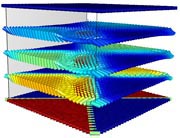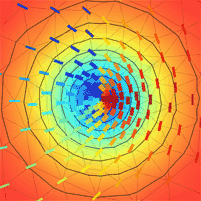|
| INFORMATION FOR Prospective Students INFORMATION Home PROJECTS Funded QUICK LINKS Optical Devices
|
2D/3D Liquid Crystal Modelling with Constant Order
Device geometries entered using a CAD interface, allowing a wide range of complex geometric shapes. Program is very flexible and is capable of modelling large pixel sizes, using a fine discretisation, with meager memory requirements.
2D/3D Liquid Crystal Modelling with Variable Order and Flow
Flow of the liquid crystal is calculated by solving the Navier-Stokes equations with a stress tensor that takes into account the anisotropy of the LC. Mixed interpolation (P2-P1 shape functions) are used to avoid oscillatory pressure solutions. This implicit scheme leads to a larger memory use than the constant order program. However, the rapid spatial variations in the order parameter near disclinations severely limits the time step for explicit methods (<1ns!). We prefer the implicit method in this case to achieve reasonable simulation times.
Director Visualisation
Built in Extended Jones optics code, for image plots or viewing angle plots. Free energy calculation, surface and contour plots. Provides a means to rapidly convert results from irregular to regular meshes, as required for most optical calculations
This page last modified 2 June, 2006 by r.james |


 When disclinations are present, the LC ordering
becomes biaxial near the core and the order parameter drops (as
represented by the background colour of the figure to the right).
We have developed Finite Element discretisations of the Qian and
Sheng Equations in both 2D and 3D. The Qian and Sheng equations
are a generalisation of Ericksen-Leslie theory for LC hydrodynamics
to include changes in the order parameter. The Finite Element Method
is well suited to resolve the rapid variations in order parameter
about disclination whilst still being able to model large container
sizes.
When disclinations are present, the LC ordering
becomes biaxial near the core and the order parameter drops (as
represented by the background colour of the figure to the right).
We have developed Finite Element discretisations of the Qian and
Sheng Equations in both 2D and 3D. The Qian and Sheng equations
are a generalisation of Ericksen-Leslie theory for LC hydrodynamics
to include changes in the order parameter. The Finite Element Method
is well suited to resolve the rapid variations in order parameter
about disclination whilst still being able to model large container
sizes. 